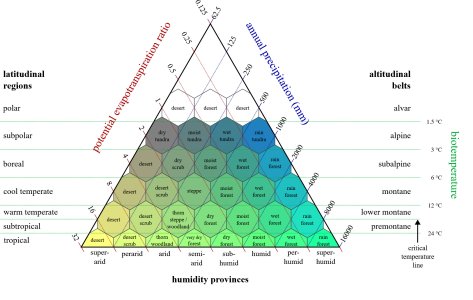If I'm interpreting the colors on the map in the first post correctly, at least the upper Great Plains is labeled as "cropland". That may well be the case today, but if we turn back the clock 200 years, the Great Plains would indeed have been wild plains. "Prairie" being another term, and while I'm sure experts could point out the differences between them, to me it's a bit of forest versus woods. One may be larger and denser, but both have a lot of trees. Plains versus prairies, if it's small and local, it's a a prairie, if it's almost all of Nebraska in 1830 and has bison, it's the plains.
Attached is a far more scientific breakdown of biomes. I'm not suggesting this as a template, but, rather, for how definitions vary between geographical, and ecological, and "commonplace"/"utilitarian" terminology - and I'm more than genuinely curious as to which of these biomes matches up top your(I'm
guessing "Steppe.") Also, "Prairie" is strictly American terminology.
Moving right along -
- "Cropland" is a utilitarian definition.
- The second map shows the area in question. The color codes are as follows: the lightest green is, “Shortgrass Prairie;” next up is, “Mixed Grass Prairie;” and the darkest is, “Tallgrass Prairie.”
- That second is today. Before we Yanks arrived, there was six feet of topsoil - which was reduced to the Dust Bowl in 1934, meaning that Things Were Different Then, before over-farming had run rampant, over the course of a century or so.
Further definitions make the matter as clear as mud. According to Ye Olde Wikipedia:
"In geography, a plain is a flat expanse of land that generally does not change much in elevation, and is primarily treeless. Plains occur as lowlands along valleys or at the base of mountains, as coastal plains, and as plateaus or uplands."
So there can be considerable differences in what a "Plains" is.
Then of course there's the classic Eurasian steppe. I suppose I've always had a similar interpretation to Virote_Considon, considering Civ3's "plains" as representing these drier grasslands (which are nonetheless not deserts), and borrowing its language from the U.S. Great Plains. Civ3's "grasslands" being the wetter grasslands of, say, France or the U.S. mid-Atlantic.
Or Ukraine.
In the end, I think Firaxis struck a decent balance, even if a more flexible system for modding would be nice. We could have had 30 different terrains types, but would it make the gameplay better? Or is the argument that Plains should be lumped in with Grassland and there should be fewer terrains?
From a gameplay POV, I'd happily ditch Flood Pains (just extremely fertile soil + Disease) and Volcanos. I'd also like to see "Jungle" replaced with "Tropical" and "Temperate" Rain Forests.
I'd ditch Plains in favor of Steppe, Grassland, and Rich Cropland (Flood Pains.)
That's -4 Tile Types, and +5 new ones. (Which, of course, can be accomplished, with LM Terrain, but the available graphics don't
 . Perhaps then it will not be necessary to cut out the Arctic.
. Perhaps then it will not be necessary to cut out the Arctic. . Perhaps then it will not be necessary to cut out the Arctic.
. Perhaps then it will not be necessary to cut out the Arctic.



